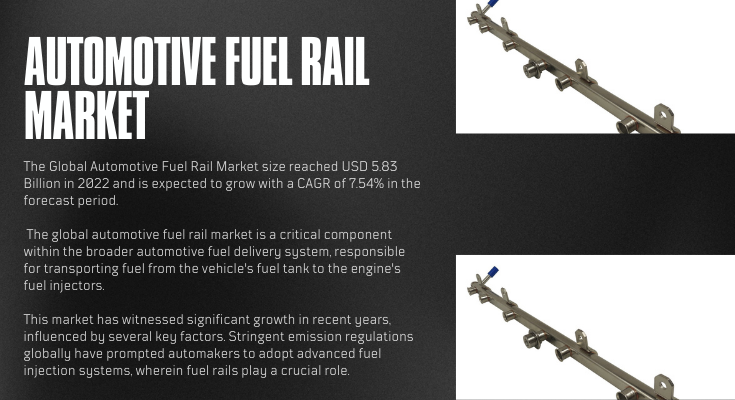According to TechSci Research report, “Automotive Fuel Rail Market – Global Industry Size, Share, Trends, Competition Forecast & Opportunities, 2028”, the Global Automotive Fuel Rail Market stood at USD 5.83 Billion in 2022 and is anticipated to grow with a CAGR of 7.54% in the forecast period, 2024-2028. The global automotive fuel rail market is witnessing a profound transformation driven by key industry trends and technological advancements. With a growing emphasis on environmental sustainability, stringent emission standards have become a primary driver, compelling automakers to adopt innovative fuel delivery systems. Fuel rails, as crucial components, play a pivotal role in optimizing fuel injection processes for cleaner and more efficient combustion.
In response to the escalating demand for fuel-efficient vehicles, manufacturers are focusing on the development of advanced fuel rail technologies. This involves the integration of cutting-edge features such as high-pressure fuel injection systems and smart technologies, contributing to enhanced engine performance and improved fuel economy. The market is characterized by a shift towards lightweight materials in fuel rail construction, with materials like aluminum and composite alloys gaining prominence. This not only reduces the overall weight of the vehicle but also aligns with the automotive industry’s broader goal of achieving fuel efficiency and reduced emissions.
The automotive fuel rail market is not only influenced by traditional fuel types like gasoline and diesel but is also adapting to the rising interest in alternative fuels. Biofuels, compressed natural gas (CNG), liquefied petroleum gas (LPG), and hydrogen are gaining traction, driving the development of fuel rail systems compatible with diverse fuel sources. This aligns with global initiatives to explore sustainable energy solutions and reduce the reliance on conventional fossil fuels.
Furthermore, the integration of smart technologies within fuel rail systems is shaping the market’s trajectory. Pressure sensors, electronic controls, and connectivity features enable real-time monitoring and optimization of fuel delivery, contributing to both performance and efficiency. As the automotive industry continues to evolve, with electric and hybrid vehicles gaining prominence, the fuel rail market is at the forefront of innovations that support a diverse range of powertrain configurations. Overall, the global automotive fuel rail market reflects the industry’s commitment to technological advancements, environmental responsibility, and the pursuit of more efficient and sustainable transportation solutions.
The global automotive fuel rail market is marked by key trends, including a focus on sustainability with the rise of alternative fuels, such as biofuels and hydrogen. Stringent emission standards drive innovations in fuel delivery systems, while lightweight materials like aluminum enhance fuel efficiency. The integration of smart technologies, like pressure sensors, elevates engine performance. As the automotive industry embraces electrification, fuel rail systems play a crucial role in supporting diverse powertrain configurations. Overall, the market is characterized by a dynamic shift towards cleaner, more efficient, and technologically advanced fuel rail solutions.
Browse over XX market data Figures spread through XX Pages and an in-depth TOC on ” Global Automotive Fuel Rail Market.” @ https://www.techsciresearch.com/report/automotive-fuel-rail-market/20158.html
North America’s automotive fuel rail market is characterized by a robust industry and a focus on innovation. Stringent emission regulations drive the adoption of advanced fuel rail systems. The region’s diverse vehicle landscape, including a significant market for light trucks and SUVs, shapes the demand for fuel efficiency, prompting continuous advancements in fuel rail technologies. Original Equipment Manufacturers (OEMs) and suppliers collaborate to meet both regulatory requirements and consumer preferences for high-performance, environmentally conscious vehicles.
Europe stands as a pioneer in the adoption of advanced automotive technologies, reflected in the automotive fuel rail market. The region has a strong inclination towards diesel-powered vehicles, influencing the design and application of fuel rail systems. European countries actively invest in research and development to integrate alternative fuels, and the market sees a continuous push for sustainable and eco-friendly solutions. Stricter emission standards and a tech-savvy consumer base contribute to Europe’s leadership in shaping the future of fuel rail technologies.
The Asia-Pacific region emerges as a powerhouse in the automotive fuel rail market, driven by the rapid growth of the automotive industry. Countries like China and India, with surging vehicle demand, contribute significantly to the region’s dominance. The preference for gasoline-powered vehicles and government initiatives promoting alternative fuels stimulate the demand for innovative fuel rail systems. Asia-Pacific is not only a major consumer but also a key innovator, with local manufacturers actively involved in the development of cutting-edge fuel rail technologies.
Latin America represents a region with evolving trends in the automotive fuel rail market. With the rising middle class and growing urbanization, the demand for fuel-efficient vehicles is increasing. Brazil and Mexico, in particular, witnessed a surge in consumer interest in environmentally conscious options. The market dynamics are shaped by economic factors, consumer preferences, and the gradual shift towards alternative fuels. Collaborations between regional manufacturers and global suppliers contribute to the adaptation of fuel rail systems to local requirements.
The Middle East and Africa present an emerging market in the automotive fuel rail segment. Economic growth, urbanization, and a focus on sustainability contribute to the increasing demand for advanced fuel rail technologies. The region’s preference for larger vehicles, including SUVs and pickups, influences the design and application of fuel rail systems. Governments exploring alternative fuels and sustainable transportation solutions provide opportunities for fuel rail manufacturers to align their offerings with the evolving needs of the region. The aftermarket segment, driven by vehicle customization trends, further contributes to the dynamics of the fuel rail market in the Middle East and Africa.
Major companies operating in the Global Automotive Fuel Rail Market are:
- Cooper-Standard Automotive Inc
- Magneti Marelli S.p.A.
- Roberts Bosch GmbH
- Continental AG
- Nikki Co. Ltd.
- Landi Renzo S.p.A
- Linamar Corporation
- AISIN SEIKI Co. Ltd.
- Sanoh Industrial Co. Ltd.
- TI Fluid Systems
Download Free Sample Report @ https://www.techsciresearch.com/sample-report.aspx?cid=20158
Customers can also request 10% free customization in this report.
“A transformative trajectory for the automotive fuel rail market. With a laser focus on sustainable solutions, they anticipate a surge in demand for fuel rail technologies compatible with alternative fuels, meeting global emission goals. The integration of smart features and lightweight materials is seen as a key trend, enhancing fuel efficiency. As the industry undergoes a paradigm shift towards electrification, experts foresee fuel rail systems playing a pivotal role in supporting diverse powertrain configurations, ensuring a greener and technologically advanced automotive landscape,” said Mr. Karan Chichi, Research Director with TechSci Research, a research-based management consulting firm.
“Automotive Fuel Rail Market – Global Industry Size, Share, Trends Opportunity, and Forecast, Segmented By Fuel Type (Gasoline, Diesel and Alternative Fuel), By Engine Type (Engine and V-Engine), By Material (Steel, Aluminum and Others), By Region, Competition, 2018-2028”, has evaluated the future growth potential of Global Automotive Fuel Rail Market and provides statistics & information on market size, structure, and future market growth. The report intends to provide cutting-edge market intelligence and help decision makers take sound investment decisions. Besides, the report also identifies and analyzes the emerging trends along with essential drivers, challenges, and opportunities in the Global Automotive Fuel Rail Market.
You may also read:
Hopper Car Market Insights- Strategies for Success in a Competitive Landscape [2028]
Automotive Wheel Speed Sensor Market Report- Understanding Market Size, Share, and Growth Factors [2028]
Autonomous Vehicle ECU Market Trends- Navigating the Path to Sustainable and Effective Solutions
Metal Foam Market – Unveiling Growth Trends & Analysis [2028]
Oil and Gas Valves Market Insights- Strategies for Success in a Competitive Landscape
Table of Content-Automotive Fuel Rail Market
- Introduction
1.1. Product Overview
1.2. Key Highlights of the Report
1.3. Market Coverage
1.4. Market Segments Covered
1.5. Research Tenure Considered
- Research Methodology
2.1. Objective of the Study
2.2. Baseline Methodology
2.3. Key Industry Partners
2.4. Major Association and Secondary Sources
2.5. Forecasting Methodology
2.6. Data Triangulation & Validation
2.7. Assumptions and Limitations
- Executive Summary
3.1. Market Overview
3.2. Market Forecast
3.3. Key Regions
3.4. Key Segments
- Impact of COVID-19 on Global Automotive Fuel Rail Market
- Global Automotive Fuel Rail Market Outlook
5.1. Market Size & Forecast
5.1.1. By Value
5.2. Market Share & Forecast
5.2.1. By Fuel Type Market Share Analysis (Gasoline, Diesel, and Alternative Fuel)
5.2.2. By Engine Type Market Share Analysis (Engine and V-Engine)
5.2.3. By Material Market Share Analysis (Steel, Aluminum and Others)
5.2.4. By Regional Market Share Analysis
5.2.4.1. Asia-Pacific Market Share Analysis
5.2.4.2. Europe & CIS Market Share Analysis
5.2.4.3. North America Market Share Analysis
5.2.4.4. South America Market Share Analysis
5.2.4.5. Middle East & Africa Market Share Analysis
5.2.5. By Company Market Share Analysis (Top 5 Companies, Others – By Value, 2022)
5.3. Global Automotive Fuel Rail Market Mapping & Opportunity Assessment
5.3.1. By Fuel Type Market Mapping & Opportunity Assessment
5.3.2. By Engine Type Market Mapping & Opportunity Assessment
5.3.3. By Material Market Mapping & Opportunity Assessment
5.3.4. By Regional Market Mapping & Opportunity Assessment
- Asia-Pacific Automotive Fuel Rail Market Outlook
6.1. Market Size & Forecast
6.1.1. By Value
6.2. Market Share & Forecast
6.2.1. By Fuel Type Market Share Analysis
6.2.2. By Engine Type Market Share Analysis
6.2.3. By Material Market Share Analysis
6.2.4. By Country Market Share Analysis
6.2.4.1. China Market Share Analysis
6.2.4.2. India Market Share Analysis
6.2.4.3. Japan Market Share Analysis
6.2.4.4. Indonesia Market Share Analysis
6.2.4.5. Thailand Market Share Analysis
6.2.4.6. South Korea Market Share Analysis
6.2.4.7. Australia Market Share Analysis
6.2.4.8. Rest of Asia-Pacific Market Share Analysis
6.3. Asia-Pacific: Country Analysis
6.3.1. China Automotive Fuel Rail Market Outlook
6.3.1.1. Market Size & Forecast
6.3.1.1.1. By Value
6.3.1.2. Market Share & Forecast
6.3.1.2.1. By Fuel Type Market Share Analysis
6.3.1.2.2. By Engine Type Market Share Analysis
6.3.1.2.3. By Material Market Share Analysis
6.3.2. India Automotive Fuel Rail Market Outlook
6.3.2.1. Market Size & Forecast
6.3.2.1.1. By Value
6.3.2.2. Market Share & Forecast
6.3.2.2.1. By Fuel Type Market Share Analysis
6.3.2.2.2. By Engine Type Market Share Analysis
6.3.2.2.3. By Material Market Share Analysis
6.3.3. Japan Automotive Fuel Rail Market Outlook
6.3.3.1. Market Size & Forecast
6.3.3.1.1. By Value
6.3.3.2. Market Share & Forecast
6.3.3.2.1. By Fuel Type Market Share Analysis
6.3.3.2.2. By Engine Type Market Share Analysis
6.3.3.2.3. By Material Market Share Analysis
6.3.4. Indonesia Automotive Fuel Rail Market Outlook
6.3.4.1. Market Size & Forecast
6.3.4.1.1. By Value
6.3.4.2. Market Share & Forecast
6.3.4.2.1. By Fuel Type Market Share Analysis
6.3.4.2.2. By Engine Type Market Share Analysis
6.3.4.2.3. By Material Market Share Analysis
6.3.5. Thailand Automotive Fuel Rail Market Outlook
6.3.5.1. Market Size & Forecast
6.3.5.1.1. By Value
6.3.5.2. Market Share & Forecast
6.3.5.2.1. By Material Market Share Analysis
6.3.5.2.2. By Engine Type Market Share Analysis
6.3.5.2.3. By Material Market Share Analysis
6.3.6. South Korea Automotive Fuel Rail Market Outlook
6.3.6.1. Market Size & Forecast
6.3.6.1.1. By Value
6.3.6.2. Market Share & Forecast
6.3.6.2.1. By Fuel Type Market Share Analysis
6.3.6.2.2. By Engine Type Market Share Analysis
6.3.6.2.3. By Material Market Share Analysis
6.3.7. Australia Automotive Fuel Rail Market Outlook
6.3.7.1. Market Size & Forecast
6.3.7.1.1. By Value
6.3.7.2. Market Share & Forecast
6.3.7.2.1. By Fuel Type Market Share Analysis
6.3.7.2.2. By Engine Type Market Share Analysis
6.3.7.2.3. By Material Market Share Analysis


